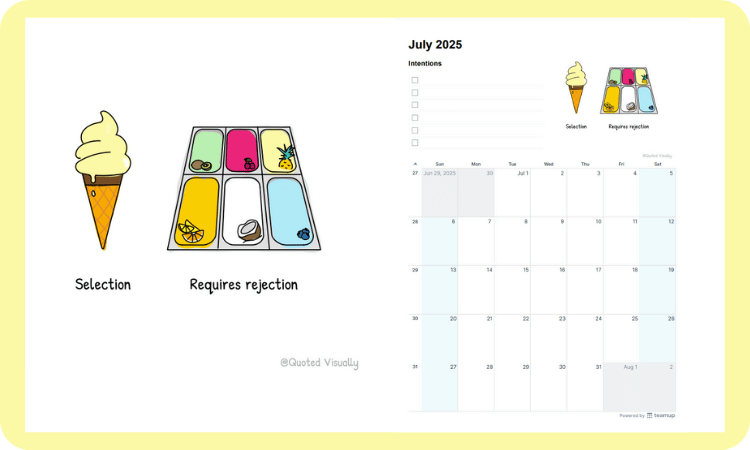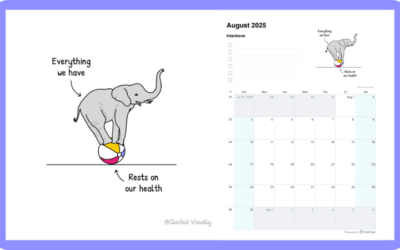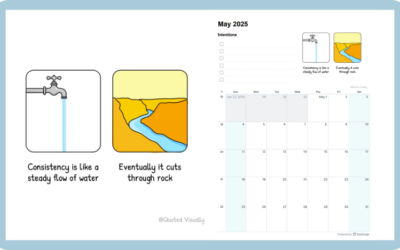Selection requires rejection. Making choices can be difficult, but it’s how we guide our own lives. Choose and plan proactively with our July illustrated calendar, available to download and print in portrait or landscape. See our complete collection of 2025 printable calendars for even more options.
Remember trying to choose the best treat as a kid? Picking one flavor from all the options felt like a high-stakes decision. Try something new or stick with a favorite? What made it tough was the same issue we still face as adults: choosing one option means letting the others go.
But without the choice, you don’t get any ice cream at all.
That’s the nature of selection: It always requires rejection. Every time we say yes to something, we’re saying no to something else. It may feel uncomfortable, but it’s the only way to move forward clearly and intentionally.
Facing endless options
We live in a world of endless options. Work projects, social invites, digital content, and personal goals surround us. Even a seemingly simple choice, like deciding what’s for dinner, opens up an array of possibilities. This abundance is a privilege, but it can also be overwhelming.
When you only have to choose between A or B, it’s easier to decide. You know what you’re choosing, and what you’re leaving behind. But when you have dozens or hundreds of options, each decision seems momentous. How can you compare so many options? Is there a way to know the option you pick is the best one? Facing all the possibilities can lead to decision paralysis.
Making peace with no
The way to escape that paralysis is by embracing your power to say no.
You don’t need to analyze every option to avoid making mistakes. Instead, look inward. Focus on your values, priorities, and preferences. When you know what matters to you, you can make choices based on internal standards rather than external factors. Pick something that fits who you are and what you need now. Once you do that, you’re free to let the other options go. You don’t need to know all that you’re letting go of; you only need to know the choice you made works for you.
Reframing rejection
Saying No is a form of rejection, and we often treat rejection as negative. But in the context of selection, rejection isn’t a failure. It’s the necessary and natural counterpart to making a proactive choice.
Saying yes to one thing means saying no to all the other things that could fill that time and space. The alternative is not choosing at all. While making no choice might feel like keeping your options open, that’s now how it really works. When you don’t choose for yourself, the choice gets made for you: Opportunities end, situations change, options disappear.
So we have to make peace with rejection. Otherwise, we end up responding reactively rather than choosing proactively.
Reacting versus choosing
There’s a big difference between reactive responses and proactive choices. Take a look:
Reactive responses
- Making rushed decisions based on external pressures or urgency.
- Defaulting to what’s easiest or most familiar, even when it’s not what you need.
- Feeling scattered, uncertain, or driven rather than focused.
- Letting interruptions take over planned priorities.
- Examples:
- Saying yes to a request just because it’s time-sensitive.
- Letting your inbox or calendar dictate your day.
- Jumping from task to task and leaving things half-done.
A day spent in reactive mode doesn’t feel good. You might be busy all day long, but you miss out on the satisfaction of making purposeful choices and following through on what matters most to you.
Proactive choices
- Making decisions intentionally based on your values, goals, and available resources.
- Planning with an eye on long-term alignment.
- Saying no confidently to what doesn’t match your priorities.
- Being flexible as the day unfolds without losing your focus.
- Examples:
- Spending time on your most important task before you deal with incoming requests.
- Being clear with others about your available time.
- Choosing one main goal or project for the week as your focus.
Selecting what’s best, now
There’s no such thing as the perfect choice.
Some opportunities you pass on might have turned out well. In the myriad of options you don’t choose, some would have been a good match. That’s okay. You don’t need to examine every possibility to make a good decision. The key is knowing your own values and priorities, and selecting what’s best for you right now. This proactive approach keeps you from letting circumstances, habits, or someone else’s urgency determine how you spend your days.
Selection requires rejection. But choosing what’s best for you, now (and being courageous enough to reject everything else) gives you the power to guide your own life.




